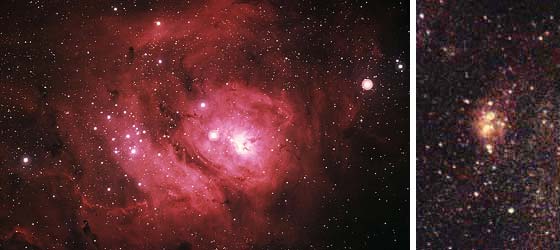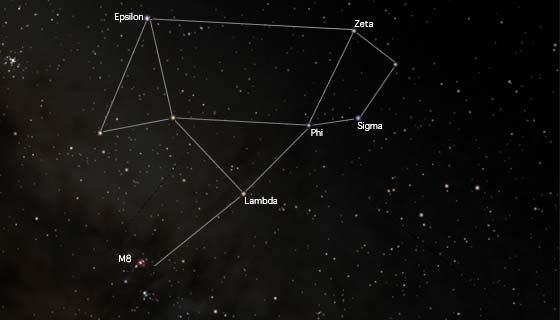
M8Basic information about M8. Its a diffuse emission nebula in Sagittarius, also known as NGC 6523, and the Lagoon Nebula. Its position is right ascension 18:03.8, declination -24:23. The distance approximately 5200 light years, its magnitude 6, the apparent size is approximately 90 by 40 arc minutes (this is equivalent to a true size of 140 by 60 light years). The cluster inside this nebula (NGC 6530) is more obvious than the nebula itself, although the nebula is easy even in small telescopes. The full extent of the nebula isn't obvious - it covers an area equivalent to 4 times the size of the full Moon! The Lagoon Nebula was discovered by Le Gentil in 1747. The associated cluster, NGC 6530, was discovered by Flamsteed about 1680. The photo on the left is by a professional observatory. Note the small dark areas which are where dust and gas is collapsing to form stars. On the right is a simple photo taken with a camera using 800 asa print film mounted piggy-back on a small telescope. 
To find M8 you need find the constellation Sagittarius. This constellation is often described as the teapot. You can see this shape (upside down for southern observers) in the diagram above. Even if you can't see a teapot, the quadrilateral and triangle shapes on either side are easy to find. If you have trouble finding Sagittarius, try starting from Scorpius and find Sagittarius near the scorpion's sting. The cluster on the left of the map near the top is M7 which is in Scorpius. After finding these shapes follow the line from Zeta to Phi to Lambda and contine in the same direction to find M8. Notice the lines curve slightly to the left, follow that curve and you should find it. The cluster is usually the first part you see. |
![[Up]](../XuShared/Up2B.jpeg)